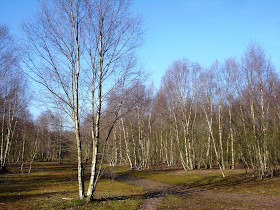 |
| Gold Leaf: Buried Sunlight.. This sculpture on the top of an old coal mining spoil heap has proved controversial - do you like it? |
 |
| A close-up, showing the layers and serrated edge. |
 |
| The base, shining against the dark stones on the surface. |
 |
| And another close-up. |
 |
| The bare stones around the base of the art-work. |
 |
| A carpet of moss is covering the spoil heap. |
 |
| Silver birches as far as the eye can see. I tried taking photos of fallen birch leaves, but they were not clear enough to use. |
Saturday Snapshot is hosted by Alyce at http://athomewithbooks.net/ where you can see photos from other participants all over the world.
Amazing sculpture! I like it, for it reflects so much meaning. It reminds me of an obelisk from ancient days but with a modern twist. Stylistically, it's beautiful, your photo is, esp. against the clear blue sky. That a work of art on that site, symbolizing nature and man co-existing... that it's situated on top of a heap of an old coal mine is fascinating. Thanks for sharing. I greatly admire that in your area there are so many interesting and mesmerizing works of art, architecture, as well as historical sites.
ReplyDeleteArti, I know I am lucky to have so many places of interest within easy reach, and to have the time to explore them.
DeleteWhat a fabulous piece of sculpture...and a wonderful symbol. Thanks for sharing the various perspectives of the "Gold Leaf." And thanks for visiting my blog.
ReplyDeleteI'm glad you like it - it has certainly provoked some very strong reactions locally.
DeleteI'm not crazy about the sculpture from a distance because it's such a stark contrast to the landscape, but close up I think it's beautiful. I love the tribute to the coal miners, and the fact that art and nature have reclaimed this piece of land.
ReplyDeleteMy photos are here: http://worducopia.blogspot.com/2013/02/snapshots-portland-japanese-garden.html
Ali, I feel much much the same way. From a distance it does seem intrusive, but close up it's much more interesting, and it seems so much more relevant when you know about it.
DeleteI like it much better close up. You miss all the detail and what really makes it great whe far away.
ReplyDeleteThat seems to be the general opinion!
DeleteWhat an interesting place! I love your shots.
ReplyDeleteThank you. It is a beautiful area, with a wealth of wildlife, and it is such a shame that it could be devastated by a High Speed railway.
DeleteI'm liking the alchemy thing and the golden birches as plantings on a reclamation area ... it's a very cool sculpture albeit driving by and seeing it from a distance is probably strange for someone knowing nothing about it! King of like the monolith in 2001: A Space Odyssey...
ReplyDeleteDrivers can see it from the M2 motorway, and I do wonder what they must think as they race past. I must re-watch 2001: A Space Odyssey - I cannot remember it at all!
DeleteEven close up you don't realise it is shaped like a birch leaf... then, when you do know, you think yes, that's what it's all about, and it all becomes much more obvious.
ReplyDeleteI especially love the sculpture up close.
ReplyDeleteIt's odd, because it's obviously been designed to be viewed from a distance, yet its significance is only apparent close to, when you know about it, and its meaning is as hidden as the leaves being transformed in the ground.
DeleteIt's interesting to be sure, but it kind of looks like it was stuck in the middle of nowhere.
ReplyDeleteThere are no houses or buildings in the immediate vicinity - the nearest places are villages. It's on a spoil heap, which forms a hill on the site of an old coal mine, and there are lots of trees, shrubs, mosses, so yes, it is stuck in the middle of nowhere, and I think that is why some people don't like it and feel it is intrusive in that particular location.
DeleteI love the sculpture, Christine! It's fascinating. Love the photos and the one of the birches too.
ReplyDeleteIt fascinates me Fran. But it does seem to be one of those things people love or hate, and it seems to inspire some strong feelings.
DeleteThose are really amazing photos.
ReplyDeleteIt's quite an amazing piece of art, and it was such beautiful weather that day. Sadly, winter returned a couple of days later!
Delete